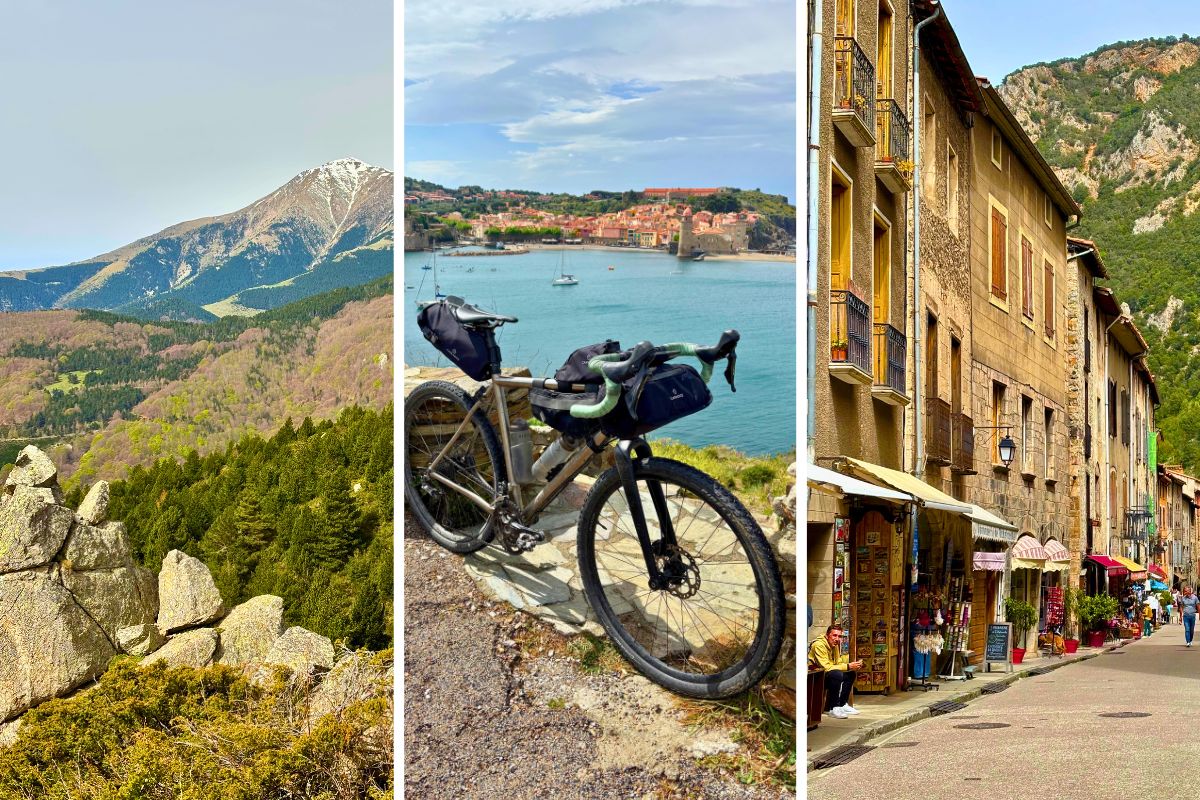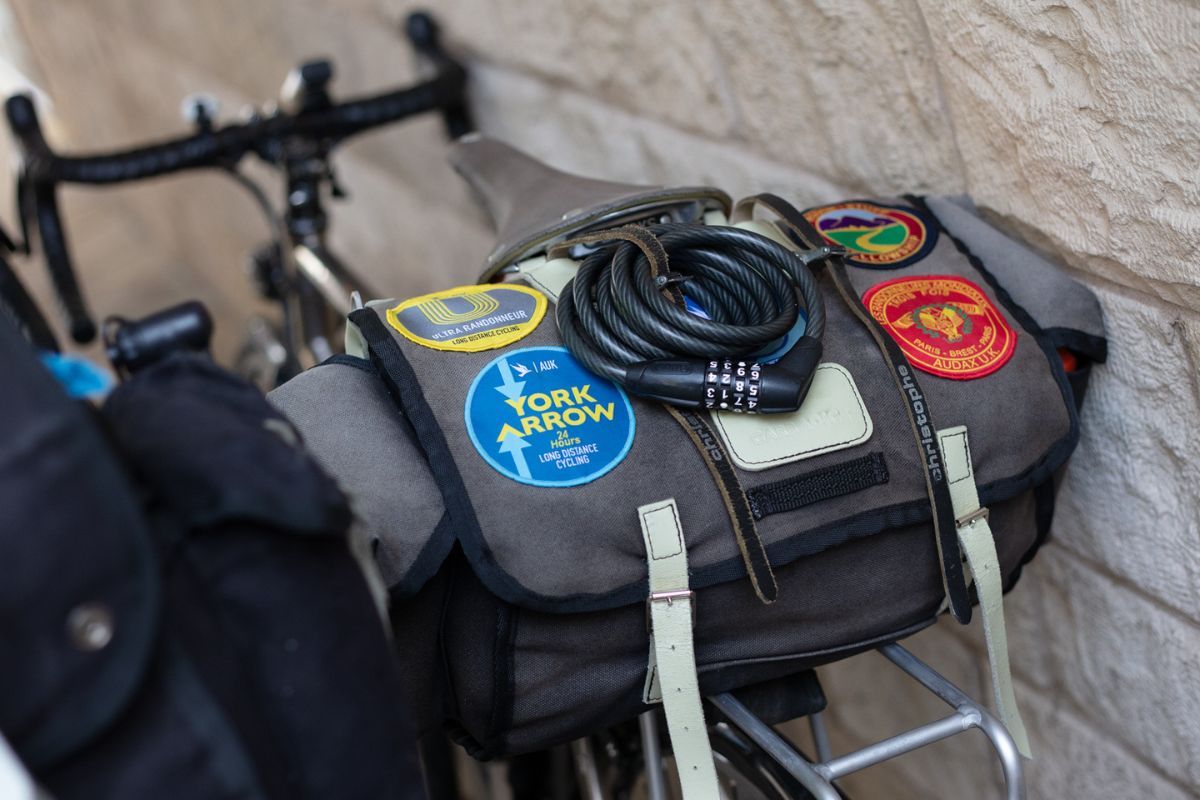Why do you ride a bike? Is it for fitness? Is it for the camaraderie amongst like-minded people? Is it for the simple act of getting from A to B? Is it for adventure? Perhaps you simply ride just for the hell of it?
Every kind of cyclist has their reason to ride, and for those drawn into the wonderful and somewhat wacky world of Audax, it could be - from the outside - hard to pinpoint why, oh why you’d want to ride 300km, in less than 24 hours, pushing body and mind to, and often beyond the ragged edge. As Eleanor Jaskowska told fellow Audax rider Fergus Coyle, when he asked her what motivates her long-distance riding: “I’m still trying to work this out!”
Carradice has long been synonymous with Audax, and so for the first time, we felt it was time to put together an Audax 101 - an introductory guide to the world of long-distance riding.

Badges are a calling card of a successful Audax completion. Image: Fergus Coyle
What is an Audax?
Audax cycling refers to long-distance cycling events designed to challenge riders over extended routes, typically ranging from 200km to distances of over 1,200km.
Unlike traditional competitive cycling events, Audax rides are non-race events where the aim is to complete the distance within a specified time limit. The focus is on endurance, self-sufficiency, and ultimately completing the route in its entirety.
To complete most Audax events, riders must pass through a series of checkpoints along the route. Often referred to as a control, riders are required to stop and produce a ‘Brevet Card’ which organisers will stamp as proof of the appearance of the rider at the control. At some controls, a simple question must be answer,ed thus further proving the rider's presence.

Typical scenes at an Audax control. Image: Fergus Coyle
As a cycling discipline, Audax sits at the crossroads between non-competitive cycle touring, where a sense of adventure dominates, and bikepacking races, where riders compete in the very traditional sense - that is, the fastest wins.
The etymology of the word Audax begins with the Latin verb ‘audere’, which translates as ‘to dare’ - this spirit of adventure, the challenge of riding a set distance in a set time, is what still puts the fire in the belly of an Audax event today.
What’s the difference between a Brevet and an Audax?
Let’s confuse matters further by telling you that the term ‘Brevet’ (Audax UK refer to this as Brevet Randonneur or BR) describes an Audax over 200km, whereas a ‘Brevet Populaire’ (BP) refers to one under that same 200km mark.
What is the difference between Randonneuring and Audax?
In the UK, ‘Randonneuring’ and Audax are used to describe the same type of long-distance riding. In other countries, such as France, there is a difference.
Under strict Audax conditions, riders stay together as a group, whereas a randonneur allows riders to pedal alone, stopping, eating and sleeping as they please.
Being based in the UK, we’ll stick with the term Audax - but ultimately for the purposes of this article, Audax and randonneuring are one and the same thing.

If riding an Audax wasn't challenging enough, some ride these bonkers events with a fixed gear! Image: Fergus Coyle
The origins of Audax
The Audax format dates back to the early 20th century in France and Italy. It began when a group of cyclists, inspired by long-distance challenges, wanted to create a course that tested not only speed but also stamina and navigation skills.
By the 1920s, this concept became formalized in the form of organized rides, often characterized by scenic routes and a spirit of adventure.
The Audax Club Parisien serves as the global governing authority for audax and randonneuring and is well-known for organizing the renowned 1200km randonnée, Paris-Brest-Paris.
A potted history of Audax
In the late 1800s in Italy, long-distance "challenge" sports gained popularity, with participants striving to cover maximum distances and demonstrate their audacity, or "audax."
The first documented audax cycling event took place on June 12, 1897, when twelve Italian cyclists undertook the challenge of riding from Rome to Naples, a distance of 230km (140 miles), during daylight.
Such events soon spread to other regions, where leading French journalist Henri Desgrange (Yes, that’s the same Desgrange of Tour de France fame) looked to capitalise on their popularity for his publication, Auto. In 1904, he published the first known set of Audax regulations.
According to these rules, riders were required to travel as a group (see the difference between audax and randonneuring above), and those who completed the challenge received a certificate known as a Brevet d'Audax. A collective of successful audax cyclists eventually created the Audax Club Parisien (ACP), which began organising events on Desgrange's behalf.

Audax routes cover some eye-watering distances. Image: Fergus Coyle
However, in 1920, a conflict arose between Desgrange and the ACP, resulting in Desgrange revoking the ACP's permission to conduct events under his regulations. Consequently, the ACP developed its free-paced version of the sport, referred to as allure libre, and awarded certificates called Brevets des Randonneurs to successful participants. This format is now commonly recognized as "randonneuring."
Desgrange continued to advocate for the original Audax rules, leading to the formation of the Union of Parisian Audax Cyclistes (UACP) on July 14, 1921. This organisation later became the Union of French Audax in January 1956 and eventually adopted the name Union des Audax.
As Audax developed in other countries, most events have adopted and continue to run events under ACP rules. Audax UK was founded in 2007 and to this day remains affiliated with the ACP.

Scenes on an Audax. Image: Fergus Coyle
Audax Formats
Audax rides come in various formats and distances, but in the simplest terms, they are classified by distance. Each distance has an associated time limit calculated using an average speed.
- 200km - 13.5 hours
- 300km - 20 hours
- 400km - 27 hours
- 600km - 40 hours
- 1,000km 75 hours
- 1,200km - 90 hours
Preparing for an Audax
Preparation is key to completing an Audax ride. Here are things to consider if you’ve entered your first Audax.
Training Rides
Even to a regular cyclist, a 200km ride can be extremely daunting. The required average speeds for Audax events aren’t crazy, so the old adages that apply to most endurance events apply here, too. Start gradually by increasing the distance you ride, integrating both long and short rides to build stamina and aid recovery.
Ride varied terrain
It's a good idea to ride on terrain resembling the actual Audax route you plan to complete. If possible, go out and take on some hills so you can experience the challenge of climbing (and descending) when at the limits of your reserves.
Get comfortable with a pacing strategy
Learn to gauge your pace - riding an Audax is all about completion and not ‘scratching’. Determine what works best for you in terms of speed, resting, hydration and feeding.
Audax Gear
Proper gear goes a long way to make an Audax more bearable. Sensible bike, clothing and Audax bag choices pay back in spades as you ride bleary-eyed through exhaustion.

A typical setup for riding an Audax. Image: Fergus Coyle
Is there a good bike for an Audax?
Choose a reliable bike suited for long distances. In the past, steel touring bikes were lauded for their ‘all-day comfort’ and reliability.
These days, the new breed of endurance road bikes tend to cut the mustard as Audax machines. Their geometry isn’t too racey, they often come with mudguard or rack mounts, run disc brakes and consequently have wide tyres for some extra squish.
In the past 5 years or so, the arrival of gravel bikes has meant there’s another bike type suited to riding an Audax. It’s worth noting that whilst electric bikes aren’t banned in Audax events, they will prevent a rider from completing the event, in the UK at the least.
Best clothing for an Audax
Pushing the pedals for hours on end can test cycling clothing to the limit. In our experience, riding over 6 hours or more can be made infinitely more comfortable by a pair of cycling shoes that you’ve broken in, and likewise, a set of cycling shorts that you’re happy with.
Riding long distances will probably mean riding through a variety of weather conditions. Layering can help you adapt to changing weather conditions, and flexible pieces of cycle clothing like gilets and arm warmers can be helpful to ward off an errant shower or cold wind.
Bags for an Audax
Capacity, waterproof rating, mounting and accessibility. In our book, these are the four attributes riders should be looking for when purchasing an Audax bag. Large saddlebags have tended to find favour amongst Audax riders, whilst some prefer the extra stability of a rackbag or the extra capacity of a pannier bag. Of course, added features like light loops and stash pockets are nice to have too!

An early version of the Carradice website with the Super C Audax Saddlebag
Tips for success when riding an Audax
Pack correctly
In the spirit of Audax, all riders should be self-supported. That means riders aiming for a completion should pack sensibly. Extra clothing, multi-tool, puncture repair kit, pump, phone and/or card and copious amounts of snacks are perhaps the bare minimum on an Audax kit list. Our advice is to pack your items sensibly and neatly. When tiredness hits, the frustration of not being able to find a multi-tool to tighten a loose bolt can easily send you over the edge.
Feed the engine
Scheduled stops at controls for snacks, hydration, and stretching can make a big difference when attempting a big physical challenge like an Audax. Most Audax controls are positioned with a feed stop in mind, but it's vital to keep on top of your nutrition between stops to avoid the dreaded hunger knock. In our experience, after a good cup of tea and a biscuit, the world can seem a very different place!

Feeling the distance. Image: Fergus Coyle
Pace it right
In the long-distance realm, pacing is crucial. It can be tempting to fire out of the blocks and really smash out the miles straight away, but for most riders, starting slowly, conserving energy for later stages of the ride is the best course of action. Long distances can be mentally taxing. Have a positive mindset and remain flexible with your expectations.
The Audax Community
One of the unique aspects of Audax is the strong sense of community among participants. Riders often share experiences, tips, and guidance through clubs and online forums (r/randonneuring on Reddit being a notable one). Joining an Audax club can provide additional resources, camaraderie, and an opportunity to train with experienced riders.

Hours in the saddle tend to cement relationships between riders. Image: Fergus Coyle
As Matt Swaine puts it, in his interview with Fergus Coyle, “You've got this amazing community of people who all spur each other on to go and do incredible things. I've had adventures on my bike that I would never have had by myself, because of the impetus, the encouragement, the kind of inspiration you get from all these people around you.”
5 Key Audax Events
1.Paris-Brest-Paris (PBP)
The biggie - the doyenne of randonée, Paris-Brest-Paris. Riders leave France’s capital pedalling way out west to Brest in Italy, returning home with another 1200km in their legs. If you’ve heard of the name, put not the event, you’re probably thinking of the pastry with the same name - a Choux pastry bun filled with praline cream and topped with almonds. Created to celebrate the event, the bun is shaped like a bicycle wheel and thanks to its calorific content, ideal fuel! To give Paris-Brest-Paris even more allure, it only takes place every four years.
2. London-Edinburgh-London (LEL)
Much like PBP, London-Edinburgh-London gets its acronym (LEL) and its quadrennial occurrence. This epic ride linking the English and Scottish capitals usually makes use of the flatter terrain in eastern England, tempering the difficulty of the 1500+ km route.
3. Easter Fleche
Most Audax events follow a prescribed route set by organisers. Arrows and Darts are different. They require riders to set their route to a finish, but for completion, they require a minimum distance and time. In this report, Fergus Coyle explains what it's like to ride the 360km Easter Fleche.
4. London-Wales-London
Another ride where a successful completion enables riders to announce they rode to “a different country”. Leaving the outskirts of the capital, riders on the London-Wales-London Audax take in several climbs in the Chilterns and the Cotswolds before turning for home just over the border at Chepstow.
5. National 400
As Audax UK explain, the revival of the National 400 event was designed to aid riders graduate from a 300km event, which riders can complete in one calendar day, to one that requires them to push on through the night. The National 400 route varies from year to year with different Audax clubs offered the chance to host that year’s edition.
That concludes our Audax 101 a (hopefully complete) version of long-distance riding. See you on the road?



